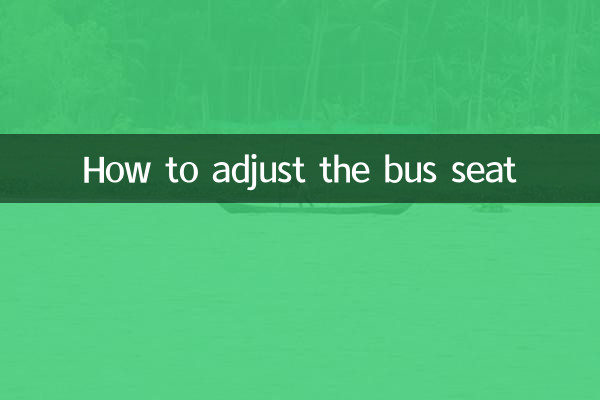How to adjust the bus seats? Analysis and practical guide of hot topics across the Internet
Recently, the topic of bus seat adjustment has sparked heated discussions on social platforms. With the arrival of the summer tourist season, how to ride long-distance buses comfortably has become the focus of passengers. This article will combine the hot discussions on the Internet in the past 10 days to provide you with structured data analysis and practical adjustment guidelines.
1. Statistics of hot topics across the entire network (last 10 days)

| platform | Amount of related topics | Popular keywords | focus of discussion |
|---|---|---|---|
| 128,000 | Seat angle and backrest adjustment | Regulating Etiquette Controversies | |
| Tik Tok | 62,000 | Comfortable sitting position and leg room | Adjustment skills demonstration |
| Zhihu | 35,000 | Ergonomics, safety regulations | Analysis from a professional perspective |
| little red book | 47,000 | Travel comfort and space utilization | Practical experience sharing |
2. Standard parameters for bus seat adjustment
| Adjustment part | Adjustable range | Recommended angle | Things to note |
|---|---|---|---|
| Backrest angle | 90°-135° | 110°-120° | Need to consider rear space |
| Seat front and rear | 10-15cm | Knees 5cm from front seat | Need to be locked after fixation |
| Headrest height | Adjustable up and down | Align the middle with the auricle | Avoid hanging your neck |
| armrest position | 2-3 gear | Naturally drooping elbows | Shared handrails need to be negotiated |
3. Correctly adjust the five-step method
1.Confirm security lock status: Check whether the seat locking device is released before adjustment to avoid damaging the mechanical structure by forced operation.
2.Basic position adjustment: First keep the backrest vertical (90°), place your feet flat on the ground, and ensure there is 2-3 finger space between your thighs and the front edge of the seat.
3.Progressive recline: Hold the adjustment handle with one hand, lean forward slightly, and gradually lean back to a comfortable position. It is recommended to pause and confirm every 15°.
4.3D coordination verification: After adjustment, the following conditions must be met: ① The line of sight can see the lower edge of the front window ② The knees of rear passengers are not pressed ③ Access to the luggage rack is not blocked.
5.final fixed check: After completing the adjustment, lean back hard to test whether the lock is secure, and hear a "click" sound to confirm that the lock is successful.
4. Controversial hot spots and etiquette norms
According to public opinion monitoring, the main controversies in the past 10 days have focused on:
-angle boundary problem: 38% of netizens believe that the recline should not exceed 30°, while 25% of passengers advocate "full adjustment rights upon purchase of tickets"
-Special night rules: The high-speed train conductor’s suggestion of “restricting large-angle recline during 22:00-6:00” received a support rate of 72%
-Lack of consultation mechanism: 89% of dispute cases are caused by passengers not communicating with the rear seat for direct adjustment.
Professional passenger transport companies recommend following"20-20 principle": Observe the rear row for 20 seconds before leaning back, and control the adjustment range within 20°. If a larger angle is needed, please actively negotiate.
5. Adjustment plan for special groups
| Crowd type | Adjust focus | alternative | Auxiliary tools |
|---|---|---|---|
| pregnant woman | Lumbar support | Use small pillows | maternity safety belt |
| elderly | head immobilization | Booster cushion | U-shaped neck pillow |
| child | vision adjustment | safety seat | Folding footrest |
| Disabled people | Pan function | Priority front row | swivel seat |
It is worth noting that many disputes have arisen recently due to passengers not understanding"Emergency reset device"existence. All compliant bus seats are equipped with an emergency reset pull cord (usually located under the seat) so that the flight attendant can quickly restore the seat to its original position in the event of an emergency.
Mastering the correct seat adjustment method not only improves travel comfort, but is also an important manifestation of travel etiquette for modern citizens. It is recommended that passengers learn the specific adjustment methods corresponding to vehicle models in advance through the Ministry of Transportation's "Ride Comfort Self-Check Mini Program" before departure to avoid embarrassment and conflicts during the journey.

check the details

check the details